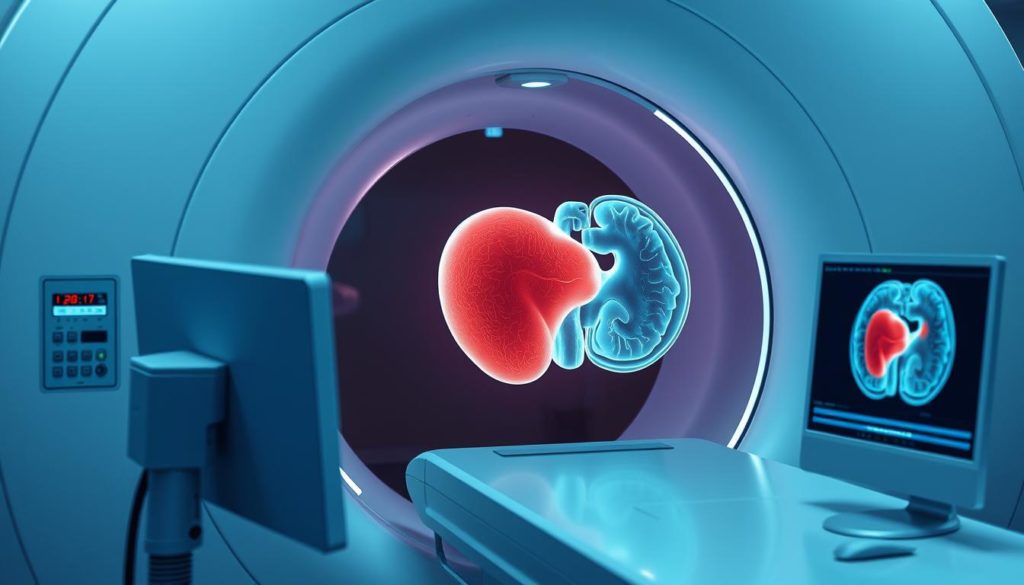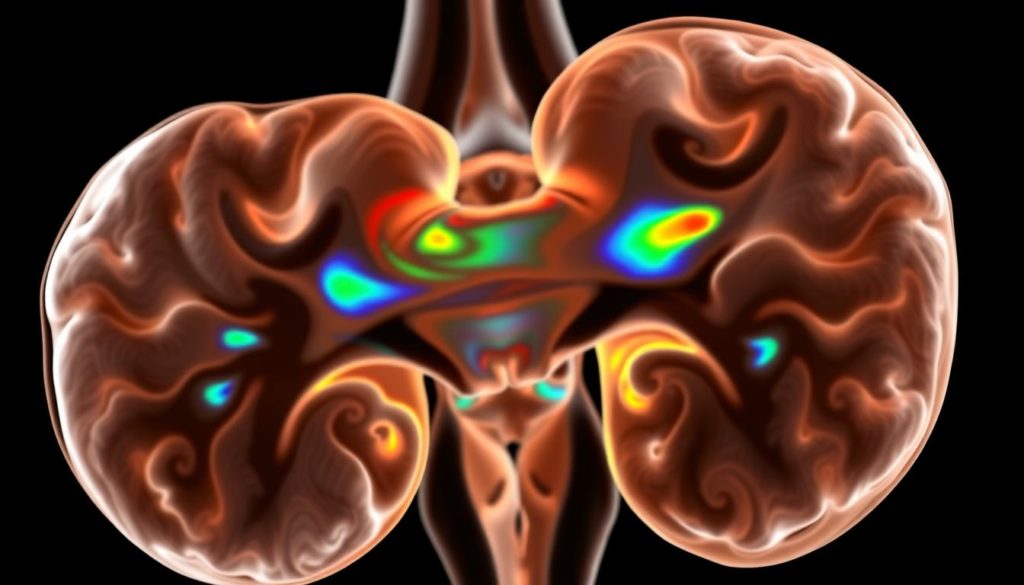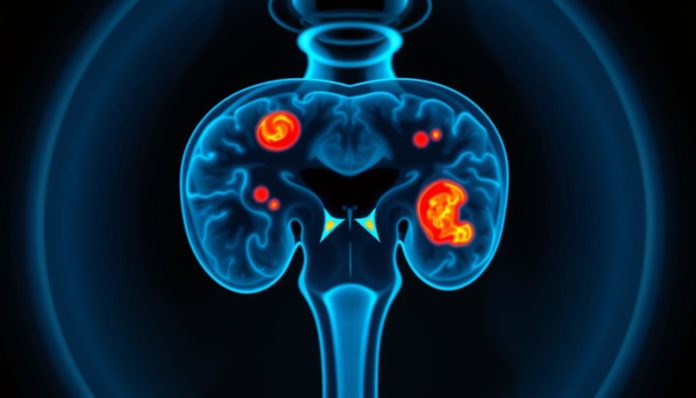Did you know prostate cancer is a major cause of cancer death in American men? This highlights the need for more accurate diagnosis tools. Prostate Cancer MRI Imaging is changing the game in detecting and treating this disease.
Advanced MRI technology brings detailed views of the prostate gland. This helps doctors tell apart benign and malignant tumors better. Unlike older methods like transrectal ultrasounds, MRI techniques for prostate cancer are more effective.
Techniques like multiparametric MRI boost diagnostic accuracy. They lower the need for biopsies that aren’t needed. They also help catch and stage prostate cancer early. This leads to better treatment success.
Introduction to Prostate Cancer MRI Imaging
Prostate cancer is a leading cause of death from cancer in men worldwide. This has led to more research and better tools for diagnosis, like MRI scans for prostate cancer. An introduction to prostate cancer MRI scan shows how crucial it is for early detection and understanding the disease.

MRI scans offer key advantages over traditional methods. A major benefit of prostate cancer MRI is that it’s safe. It doesn’t use harmful radiation like X-rays or CT scans do.
This method also makes it easier to tell cancer cells from healthy ones. This means doctors can be more accurate when they diagnose prostate cancer. Our introduction to prostate cancer MRI scan shows how it makes detection both more specific and sensitive.
New MRI technology has led to special techniques for diagnosing prostate cancer. These methods give doctors a closer look, helping in the fight against cancer. It’s clear that MRI plays a big role in modern cancer care.
| Aspect | Traditional Imaging | MRI for Prostate Cancer |
|---|---|---|
| Radiation Exposure | High | None |
| Tissue Contrast | Lower | Higher |
| Non-Invasive | No | Yes |
We are just starting to see how benefits of prostate cancer MRI can help in early detection and treatment plans. With MRI, we’re improving how we diagnose and treat patients, leading to better care.
Importance of Accurate Imaging in Prostate Cancer Detection
Accurate imaging is key to better prostate cancer detection. Techniques like multiparametric MRI have boosted the accuracy of finding prostate cancers that need treatment. These detailed images help with biopsies and understanding the cancer’s stage.

Improving Diagnostic Confidence
When imaging is accurate, doctors can be more confident in their decisions. This means they can better identify cancers that need treatment. This helps them plan the right treatment and follow-up for their patients.
Reducing Unnecessary Biopsies
Better imaging means fewer unnecessary biopsies. This saves money and spares patients from discomfort and the risks of these procedures. It leads to biopsies only when and where they’re truly needed.
Early Detection and Better Outcomes
Finding prostate cancer early leads to better chances of successful treatment. Accurate imaging is a big part of finding cancer early. It allows doctors to start treatment sooner. Studies show MRI-based screening helps avoid unneeded biopsies but still finds important cancers.
| Benefits | Accurate Imaging | Traditional Techniques |
|---|---|---|
| Diagnostic Confidence | High | Moderate |
| Unnecessary Biopsies | Reduced | Frequent |
| Early Detection | Improved | Variable |
| Patient Comfort | Enhanced | Lower |
| Healthcare Costs | Reduced | Higher |
Advanced MRI Technology for Prostate Cancer
Advanced MRI tech is changing how we diagnose and assess prostate cancer. Techniques like the 3 Tesla MRI give us clear images of the prostate. This helps us see and pinpoint cancerous spots better.
Research shows MRI with higher Tesla strength catches more tumors due to better image quality. Doctors now consider high-tech MRI crucial in battling prostate cancer. It gives clearer and more detailed pictures, enhancing cancer detection.
MRI Techniques Used in Prostate Cancer Diagnosis
Several advanced MRI methods help diagnose prostate cancer. They provide detailed views into tissue features. This helps doctors tell the difference between harmful and non-harmful lesions. As a result, it boosts the accuracy of diagnoses and aids in better patient care.
Multiparametric MRI (mpMRI)
Multiparametric MRI (mpMRI) uses a mix of MRI techniques. It aims to improve how well prostate lesions are spotted and understood. By using T2-weighted, diffusion-weighted imaging (DWI), and dynamic contrast-enhanced MRI (DCE-MRI), mpMRI makes images clearer. This helps doctors make better decisions about patient care.
Diffusion-Weighted Imaging (DWI)
Diffusion-Weighted Imaging (DWI) looks at how water moves in tissues. It gives clues about how dense tissue is and how aggressive a tumor might be. DWI is key in finding possible cancers. It shows where water doesn’t move freely, pointing to cancer.
Dynamic Contrast-Enhanced MRI (DCE-MRI)
Dynamic Contrast-Enhanced MRI (DCE-MRI) uses dyes to see blood flow in the prostate. It tells cancers apart from non-cancers by looking for increased blood flow. This is a clear sign of cancer. DCE-MRI is a critical tool in a full MRI strategy for diagnosing prostate cancer.
| MRI Technique | Key Features | Diagnostic Value |
|---|---|---|
| Multiparametric MRI (mpMRI) | Combines anatomical and functional sequences | Improves detection and characterization of lesions |
| Diffusion-Weighted Imaging (DWI) | Assesses water molecule movement | Indicates tissue cellularity and tumor aggressiveness |
| Dynamic Contrast-Enhanced MRI (DCE-MRI) | Uses contrast agents to visualize blood flow | Distinguishes between benign and malignant lesions |
Benefits of Prostate Cancer MRI Screening
The benefits of prostate cancer MRI screening are very important for men at risk. It mainly helps by using prostate MRI for early detection. This improves chances of finding serious tumors that need treatment.
- Enhanced imaging accuracy leading to more precise biopsies.
- Better treatment planning through detailed visuals.
- Active participation in surveillance programs.
- Minimizing the detection of clinically insignificant cancers.
- Reducing overdiagnosis and overtreatment.
The advantages of MRI in prostate cancer screening help greatly in preserving patient’s life quality. Integrating MRI scanning in early checking helps balance risks and benefits. It manages prostate cancer detection and treatment well.
Enhancing Prostate Cancer Accuracy with MRI
To improve the accuracy of prostate MRI, it’s important to focus on scanner settings and use standardized systems. This helps doctors diagnose more accurately. It means they can give the right treatments for prostate cancer.
Optimal Scanner Settings
Choosing the right MRI scanner settings is key for clear prostate cancer images. The scanner’s strength, in Tesla, really matters. A 3T scanner offers great picture quality, spotting problems in the prostate better.
Tweaking echo and repetition times also helps. It makes the images sharper, showing prostate tissues in detail.
Role of PI-RADS in Standardized Reporting
The PI-RADS system is crucial for consistency in MRI reports. It grades possible problem areas using set rules. This way, radiologists at any hospital can make reports that match, improving prostate cancer diagnosis.
| PI-RADS Category | Description | Probability of Clinically Significant Cancer |
|---|---|---|
| PI-RADS 1 | Very low (clinically significant cancer is highly unlikely to be present) | 1% |
| PI-RADS 2 | Low (clinically significant cancer is unlikely to be present) | 10% |
| PI-RADS 3 | Intermediate (the presence of clinically significant cancer is equivocal) | 30% |
| PI-RADS 4 | High (clinically significant cancer is likely to be present) | 60% |
| PI-RADS 5 | Very high (clinically significant cancer is highly likely to be present) | 90% |
Combining MRI with Other Diagnostic Tools
Using MRI with tests like PSA or ultrasound improves prostate MRI accuracy. It gives a fuller picture for identifying and classifying prostate cancer. This complete check is essential for deciding on the best treatments.
Prostate Cancer MRI Imaging: Real-World Applications
Prostate cancer MRI imaging has a big role in the real world. It shows its value through studies and trials. These explain how MRI changes the game in fighting prostate cancer.
Case Studies and Clinical Trials
Case studies on MRI use in prostate cancer show its benefits. Clinical trials also highlight the growth of MRI technology. They compare MRI methods to find the best one for diagnosis and patient care.
- Evaluation of multi-parametric MRI for early-stage prostate cancer detection.
- Comparative studies on the diagnostic efficacy of mpMRI versus traditional biopsy methods.
- Examining the role of advanced MRI features in tailoring personalized treatment plans.
Patient Experiences and Testimonials
Patient stories about prostate MRI share the good and hard parts of the experience. They talk about feeling more certain and less need for biopsies.
Important points from patient testimonials on prostate MRI:
“The MRI was a game-changer for my diagnosis. It allowed my doctor to pinpoint the exact location of the tumor and plan a precise treatment strategy.” – A Prostate Cancer Patient
“Having an MRI scan made me feel more secure about my treatment. The detailed images gave us a clear understanding of my condition.” – Another Patient
These examples show how prostate cancer MRI imaging is changing patient care for the better.
MRI-Guided Prostate Cancer Treatment
MRI is crucial for diagnosing prostate cancer and guiding its treatment. It uses advanced imaging to target cancer tissues with precision. This ensures each patient gets a personalized treatment plan.
Focal Therapy Techniques
Focal therapy treats specific prostate areas, protecting nearby tissues. MRI imaging accurately shows the cancer’s location for precise treatment. Patients experience fewer side effects thanks to this focused approach.
Minimally Invasive Options
Doctors prefer minimally invasive treatments for their efficiency and low risk of severe side effects. Techniques like HIFU and cryotherapy use MRI for unmatched accuracy. This minimizes the need for invasive surgeries.
Reducing Side Effects and Complications
MRI-guided treatment helps maintain urinary and sexual functions. It gives clear images that allow doctors to avoid critical areas. This reduces treatment-related side effects, improving patients’ life quality.
Challenges and Limitations of Prostate Cancer MRI
Even with better imaging tech, prostate cancer MRI faces big hurdles. It’s crucial to know these issues to fully use MRI for prostate cancer detection and evaluation.
Cost and Accessibility
The challenges of prostate cancer MRI start with its high price and limited reach. The cost of advanced MRI equipment and the needed setup is a big hurdle.
Also, getting a high-quality MRI for prostate cancer is tough in areas with few resources and in rural spots. This makes it hard for everyone to get this key diagnostic tool.
Technical Expertise Required
The need for high skill levels to do and read MRI scans is another big challenge. The skill of radiologists can vary. This leads to different outcomes even when using standardized systems like PI-RADS.
This can change the accuracy of diagnoses and treatment plans. Hence, ongoing training and strict quality checks are vital to lessen MRI limitations in prostate cancer detection.
Potential False Positives/Negatives
Prostate cancer MRI scans can mistakenly flag cancer when there isn’t any, or miss it when there is. This is a known MRI limitation in prostate cancer detection.
Such errors can make choosing the right treatment harder. Improving how we detect cancer to lower these mistakes is a key area of study.
| Challenges | Implications |
|---|---|
| Cost and Accessibility | Limits widespread adoption; hinders access in resource-poor settings |
| Technical Expertise Required | Creates variability in diagnosis; necessitates ongoing training |
| Potential False Positives/Negatives | Complicates clinical decisions; requires enhanced detection methods |
Future Directions in Prostate Cancer MRI Imaging
The upcoming changes in prostate cancer MRI are looking very promising. New tech developments are leading the way. These include better imaging techniques and AI. This means big improvements in finding and treating prostate cancer are coming soon.
Technological Innovations on the Horizon
New tech like hyperpolarized MRI and nanotechnology is changing the game. They help us understand tumors better and see how treatments are working. This could lead to better diagnosis and treatments that are more tailored to each person. Studies like this one show how these new imaging methods could really help patients.
Potential for Increased Accuracy and Efficiency
Advanced MRI could make diagnosing prostate cancer more accurate and faster. It could mean fewer unnecessary biopsies by pinpointing tumors better. Also, improvements in how MRIs are done could mean doctors are more sure of their diagnoses. This means catching cancer early and accurately.
Integrating AI and Machine Learning
Adding AI to prostate MRI could be a big deal. AI can spot complex patterns in images that humans might miss. This could make diagnosing faster and less variable. So, results would be more consistent and reliable.
As AI gets better, its use in prostate cancer MRI will become more important. It has the power to offer care that is very precise and tailored to each patient.
Conclusion and Key Takeaways
MRI technology has greatly changed how we detect, stage, and treat prostate cancer. This article has shown us the role of multiparametric MRI (mpMRI), diffusion-weighted imaging (DWI), and dynamic contrast-enhanced MRI (DCE-MRI). Together, they make diagnosing prostate cancer more accurate.
The findings stress the value of advanced imaging in avoiding unneeded biopsies. MRI-targeted biopsies are better at spotting aggressive cancers, which helps patients. Clinical trials back up MRI’s effectiveness in practice.
Yet, we face hurdles like cost, getting access, and the need for expert knowledge. Still, the outlook is bright. Artificial intelligence could make diagnosis even better. Studies stress multiparametric MRI’s crucial role. Progress in research gives us hope for better prostate cancer care.
Want to learn more about MRI’s role in prostate cancer? Check out this detailed study on prostate cancer MRI imaging. Using advanced imaging leads to more precise and patient-focused treatment.
FAQ
What are the benefits of Prostate Cancer MRI Imaging?
Prostate Cancer MRI Imaging brings big benefits. It’s a non-invasive way to check for cancer. It gives clear pictures and doesn’t use harmful radiation. It’s also really good at finding and outlining tumors.
How does MRI improve the accuracy of prostate cancer diagnosis?
MRI, and especially its advanced type called multiparametric MRI, makes pictures of the prostate much clearer. This leads to finding important cancers more accurately. It also helps avoid unneeded biopsies.
What are the common MRI techniques used in prostate cancer diagnosis?
The key MRI methods are Multiparametric MRI, Diffusion-Weighted Imaging, and Dynamic Contrast-Enhanced MRI. They all give in-depth details about the prostate, helping doctors diagnose and stage cancer correctly.
What role does advanced MRI technology play in prostate cancer detection?
Advanced MRI tech, like the 3 Tesla MRI, provides very sharp images. These images are better at showing and finding prostate tumors. This helps in planning treatment better and improving chances of recovery.
How does MRI-guided treatment benefit prostate cancer patients?
MRI-guided treatments hit cancer right on point while keeping healthy parts safe. This method lowers the chance of bad side effects. It helps save important functions, like bladder control and sexual health.
What are the challenges and limitations of using MRI for prostate cancer?
The downsides include high costs and it’s not easy to find everywhere. Operating it needs special skills. There’s a risk of getting wrong results. And, doctors might not always agree on what the images show, even with guidelines in place.
How does combining MRI with other diagnostic tools enhance prostate cancer detection?
Using MRI with tests like the PSA or ultrasound makes checking for cancer better. It gives a fuller picture. This makes doctors more sure about their findings and helps with deciding on the best treatment.
What is the future of Prostate Cancer MRI Imaging?
The future is looking bright with new tech like hyperpolarized MRI and tiny tech improvements. There’s also hope for better use of AI and machine learning. These advances could make diagnosing prostate cancer faster, more accurate, and even predict outcomes better.


